Soon it will be boot season again and so it’s the perfect time to start a little series about different boots. First up, we’d like to discuss Jodhpur boots because they are a classic shoe closet staple even though they are not quite as popular as the Chelsea boot, which we will cover shortly. Like most boots, Jodhpurs have an equestrian root, being developed for riding after the ‘invention ‘of the Jodhpur trousers.

Understanding the History
Before the invention of the Jodhpur pants, men’s riding breeches were designed to be worn with tall boots that extended to just below the knee. However with the revolutionary design of the Jodhpur trousers, tall riding boots were no longer required as the new pants protected the inner calf from rubbing while riding. This was a boon in many ways as tall riding boots besides being expensive were also difficult to pull on and off. A less expensive boot suitable for riding with Jodhpur pants was only waiting to be designed. An ankle length boot that was easy to slip on and off and that would be relatively cheaper to make and thus easier to replace especially for growing feet , would fit the bill perfectly.
Ankle boots were already in existence at the time Jodhpur pants were designed (1890) but were very rarely used for riding. The ankle boots that were in use at the Fin de siècle included Chelsea boots (stay tuned for a separate article) and Paddock boots. It is assumed that Jodhpurs were not usually used for riding, as their design predated the Jodhpur pants. Instead, they were worn while walking in the country or working in the stables. People usually changed into tall riding boots before mounting their horses. The Jodhpur boot was thus especially designed to be worn for riding along with the Jodhpur pants.
The jury is still out as to whether the Jodhpur boot was designed in the city of Jodhpur or not but seeing as the Jodhpur pants were designed and first worn in Jodhpur. On the one hand, the very name supports the theory that it was conceived in the city of Jodhpur. On the other hand, it could also very well have been derived from the Jodhpur pants which were also known as Jodhpurs in the west and thus boots worn with them could have also been called Jodhpur boots to distinguish them from the tall riding boots. In any case, Jodhpur boots continue to be hand made in Jodhpur today. Chances are the basic design was borrowed from England with subsequent modifications in Jodhpur from where the new boot found its way back to England and came to be called the Jodhpur boot.
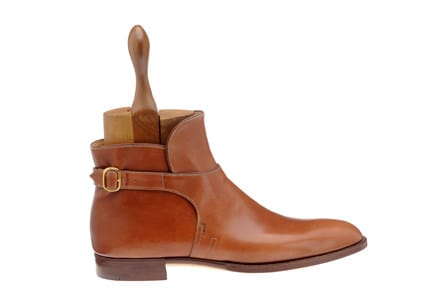
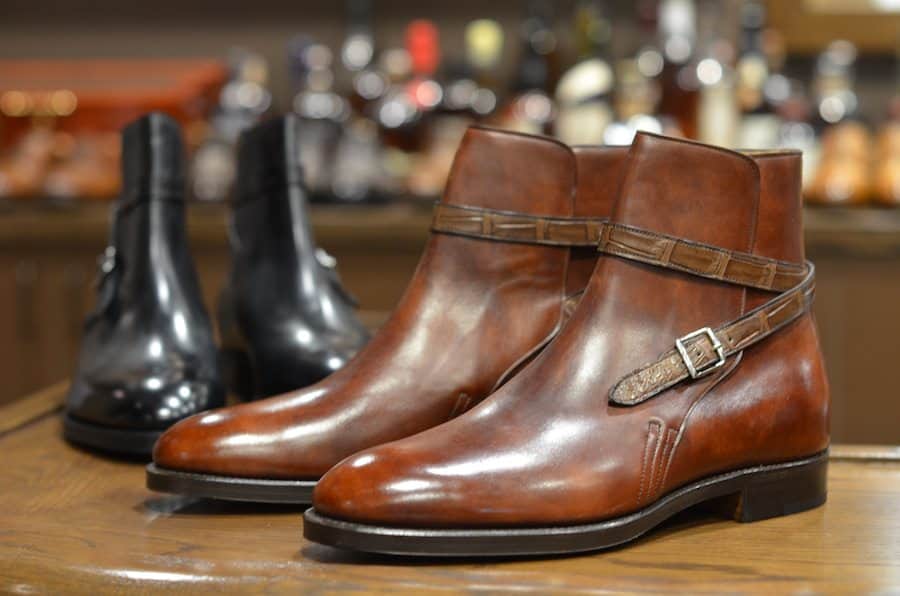
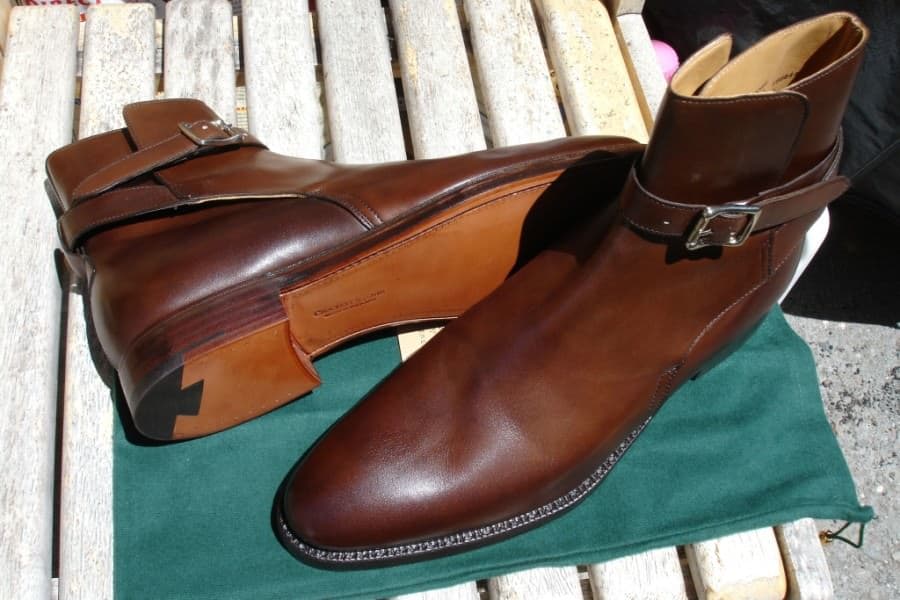
Characteristics of the Jodhpur Boots
Regardless of their place of origin, Jodhpur boots have unique characteristics that distinguish them from other ankle boots, many of which are now also used for riding.
- Ankle length.
- They have rounded toes.
- Low heels.
- Two parts each made from a single piece of leather, the vamp and the quarters.
- The vamp is sewn on top of the quarters.
- Fastened with a strap and buckle that wrap around the ankle.
- Strap is in two parts, each part attached to the vamp.
- Buckle side of the strap is attached to the inboard side and extends halfway around the ankle , counter clockwise on the right boot and vice versa on the left boot.
- The other or free end is attached to the outboard side and extends around the entire ankle clockwise on the right boot and vice versa on the left boot.
- Have a loop at the back of the boot through which the straps are passed.
There is another version available these days in which:
- The straps do not wrap entirely around the ankle.
- Both sides of the straps are attached to opposite sides of the vamp.
- Buckle side on the outboard side and the free side on the inboard side.
- The length of the buckle side is shorter than the free side.
- The free side wraps around the rear of the boot and meets the buckle side near the ankle.
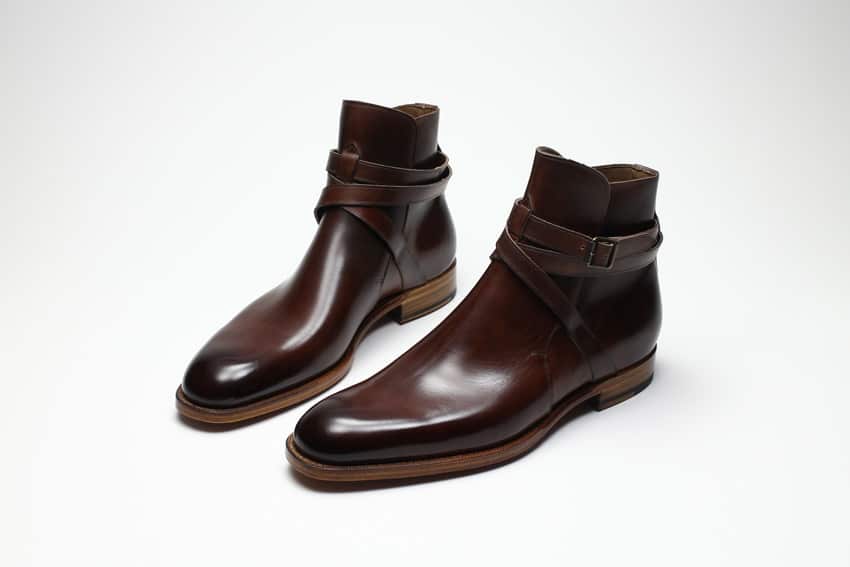
Many manufactures today advertise Jodhpur boots without straps but fitted with elastic on the sides. These are not Jodhpur boots but more like the Chelsea boot and one should not get confused between the two. The Jodhpur boots come in two variations with the characteristics described above. Any other boots regardless of what the manufacturer may call them are not Jodhpur boots.
Wearing Boots
Ankle boots have long been a part of menswear and were in fact the dominant form of men’s daytime footwear well up to the early twentieth century. It is said that when men started wearing their knee high riding boots in town when not riding , the famous dandy and arbiter of elegance of the time ( 18 th century ) Richard ‘ Beau ‘ Nash would stop them and remark “ Sir, you have forgotten your horse “. Perhaps because of his disapproval boots continued to remain a prominent feature of men’s daytime footwear in the nineteenth century. The invention of the Jodhpur pants in 1890 would surely have facilitated this style.
Boots began to dwindle in popularity sometime in the early twentieth century, perhaps due to the trend of wearing Oxford shoes in place of boots by rebellious college students. However by the 1960s the boot was back in favor and has since become a staple part of a man’s wardrobe.
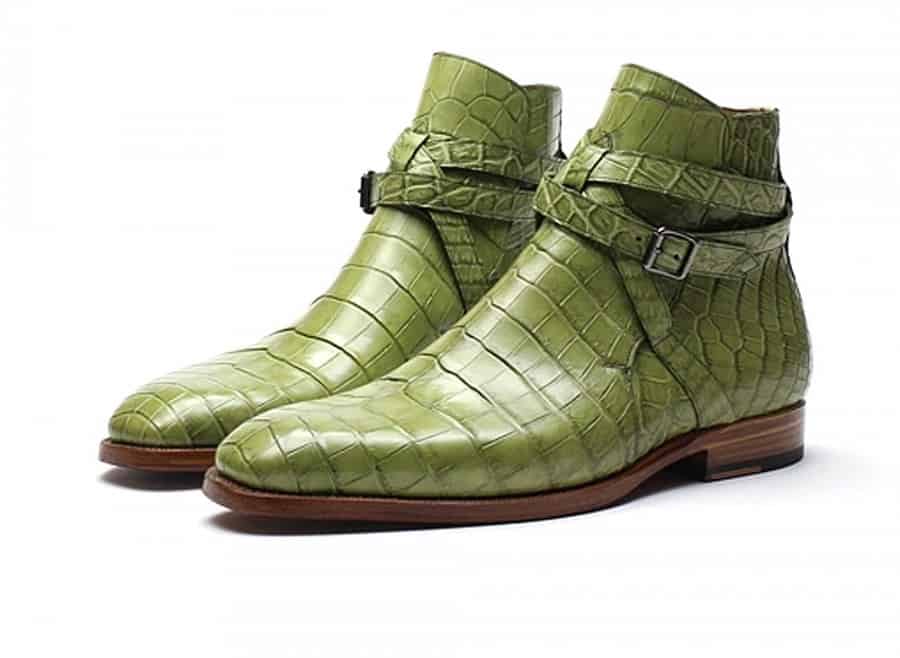
Wearing the Jodhpur boot
Wearing boots somehow exude a great sense of authority and immediately identifies the wearer as being a man of distinction. On the lighter side it also helps prevent your shins from peeking underneath your trouser cuffs! Once we decide to wear boots the next question that arises is which one? Choosing to wear Jodhpur boots instead of any of the other ankle length boots available in the market makes a lot of sense to me as it has many advantages , firstly it is an extremely intriguing boot being not as plain as the Chelsea but far more elegant . The Jodhpur boot is a very clean looking boot which has a large blank canvas of leather starting from the toe and extending all the way to the top. This lovely vast expanse of leather comes without stitching and the hint of straps peeping out from under the trousers adds to its mystique.
Traditionally associated with horseback riding, Jodhpur boots’ close fit, low heel and sleek look make them work with suits and sport coats alike. Of course, the suit should be more casual and take into account the features of the Jodhpur boot. Pay special attention to the jacket lapels, shirt collar and tie , they should be proportionate to the sleak slimness of the Jodhpur boots. For business suits, Balmoral boots or Chelsea boots can be worn alternatively. In regard to color combinations simply follow the same guidelines as you would for pairing dress shoes with suits.
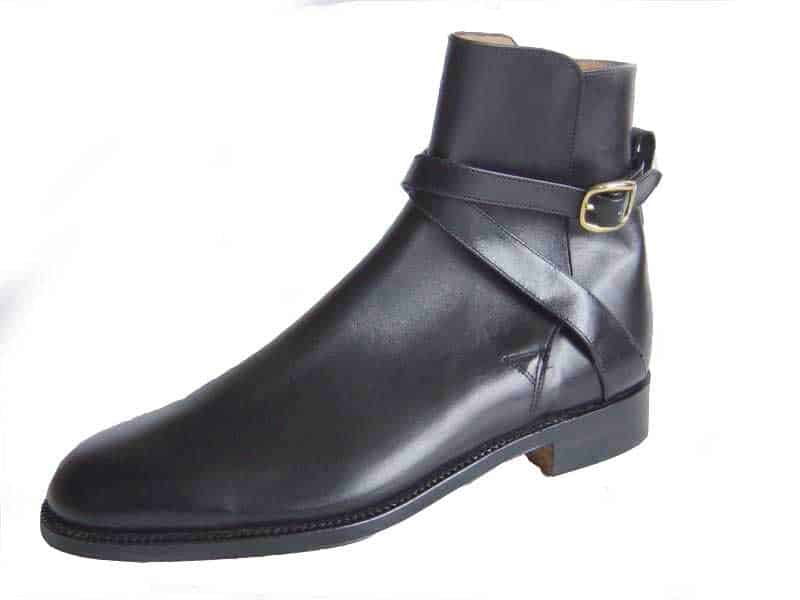
Jodhpur boots can also be worn with chinos and jeans with a number of shirts and add a leather jacket if weather permits. A solid Oxford shirt paired with straight – leg jeans is one example; one could even create a single cuff for the jeans by folding them. It advisable not to wear them with baggy trousers and they do not compliment the sleek look of the Jodhpur boots. Classic colors for the boot itself include, saddle tan and black, however, they are available in various colors and materials like suede and crocodile thus adding to their versatility and giving the wearer more room to experiment with .
In a nutshell Jodhpur boots are versatile and hence a good model to start with. However please note that one should not be worn with your trouser / jeans tucked into them, they were not designed for that and will look pretty silly and clumsy. Before taking the plunge it is always advisable to first ensure that they suit you, very often we like the look of something others wear or how it looks in a photograph only to realize afterwards that it looks rather different when we wear them ourselves.
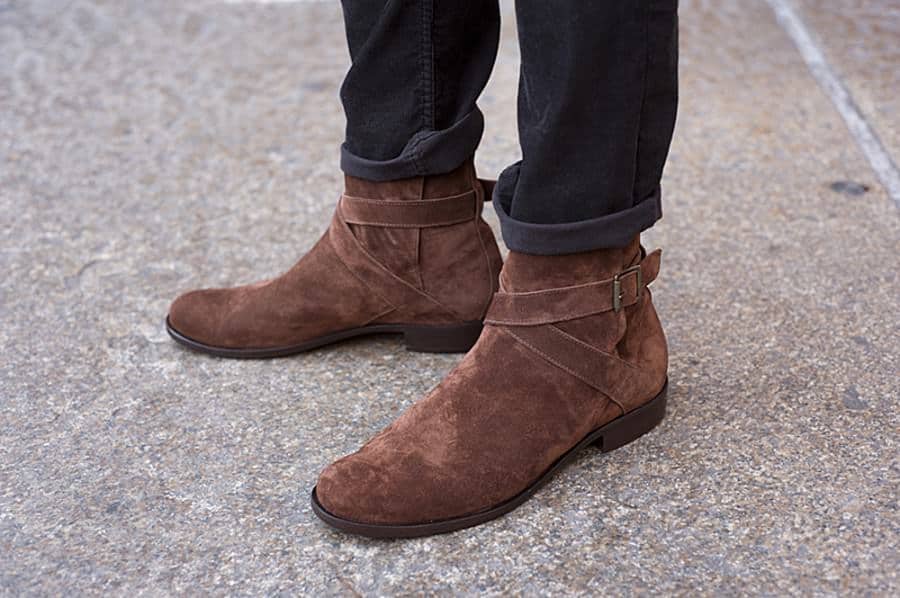
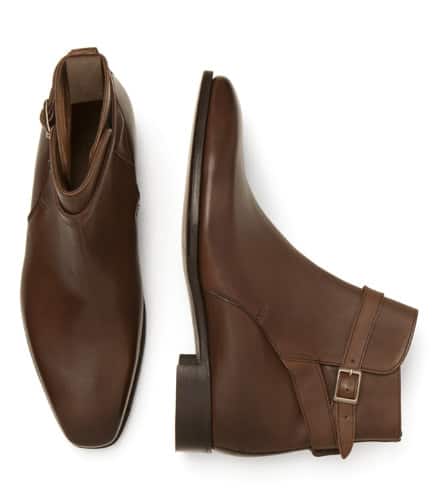
Accoutrements
There are various accessories that come with Jodhpur boots that are used both while riding as well as for maintaining them.
- Attachable Spurs – Quite essential for riding and easily removed when transiting to everyday use.
- Boot Jacks – Useful for removing your boots after a hard day.
- Chaps – Provides additional protection to the lower legs while in the saddle.
- Heel Lifter – Jodhpurs are known for their low heels, heel lifters provide a little extra lift for those who desire it.
For maintaining your Jodhpurs:
- Boot Bag – The best way to store your boots when not in use. Protects the leather both from excess moisture and reduces drying.
- Saddle Soap – To remove dirt and mud before applying polish.
- Shoe Polish – Needs no explanation and comes in all colors.
- Shoe Trees – Essential to maintain the shape of your boots after all it is the sleek look that makes them so attractive in the first place.
It is up to the individual to decide which of the above accessories are required however Jodhpur boots are an excellent investment for both riding and everyday life. Their look is timeless, functional and versatile and having these accessories will keep them in good order and prolong their life.
Where to buy Jodhpur Boots
As mentioned earlier a lot of manufactures sell a variant of the Chelsea boot as Jodhpur boots. Therefore it is essential to check the characteristics of the boots being advertised to ensure that they are indeed the genuine article.
Sanders provide a classic Jodhpur boot with good value – click here to see how they are made. Scarosso, probably offers the largest selection of RTW Jodhpur boots and they offer a Made-to-Order program that allows you to configure your own boot. For others, take a look at our Jodhpur Boots Shopping List:
| Manufacturer | Link |
|---|---|
| Sanders | Shop |
| Trickers | Shop |
| Edward Green | Homepage |
| Schnieder Boots | Website |
| John Lobb | Pricelist |
| Paul Stuart | Website |
| Zonkey Boot | Out of Stock |
| Rider Boot Co. | Website |
| Custom from Jodhpur India | Contact Information |
Of course a good place to buy the genuine article is from the place of origin and in this case that is the city of Jodhpur. I used to get them hand made there when I was in college ( 1984 – 87 ) but unfortunately I have been informed by my friend who lives in Jodhpur that the person has since passed away and his sons no longer continue the family tradition . However I did manage to find another maker in Jodhpur who claims he can supply custom made shoes from Jodhpur, I cannot however vouch for him as I have not myself used his services. Contact: Brij Raj Singh, Owner at Ratan Vilas (+91–291–2614418).
Shoes and Boots Guide
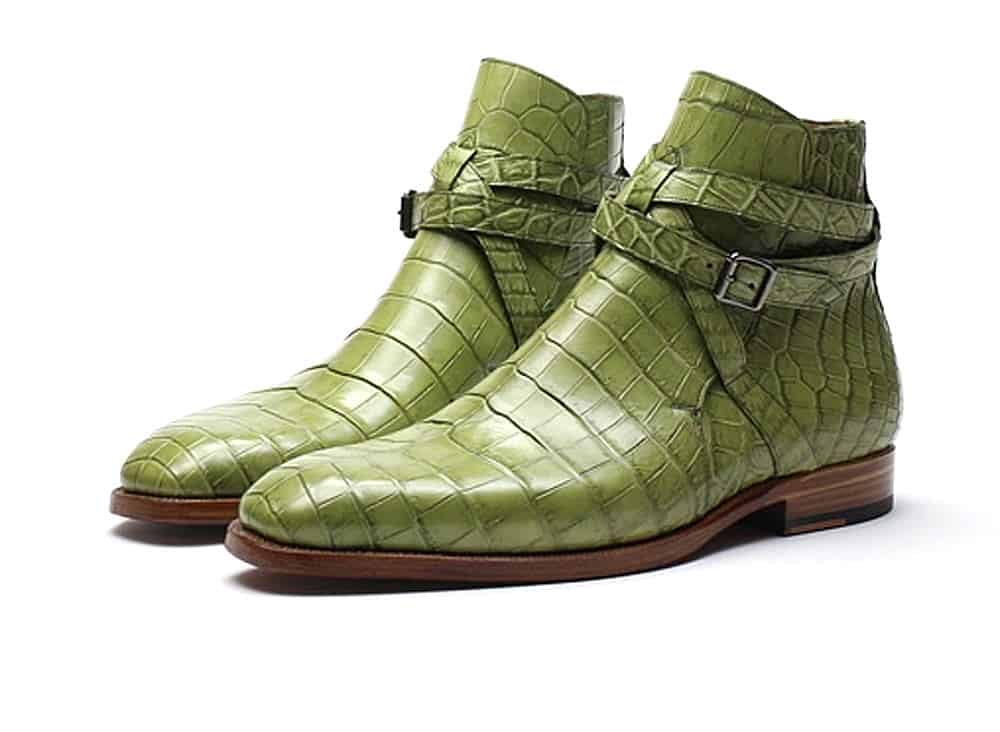
I have been wearing boots on and since my teens; calf high side zippered ones, “Beatle Boots” and such, although as I have gotten older I have worn them less. I always remember how sharp John Steed looked with boots with a suit, I did not, until reading this site, realize that Bond had done so too. Usually wear loafers unless dress requires otherwise
As always, an excellent article. I look forward to reading about Balmoral and Button boots.
Button boots are special and mostly worn by vintage lovers, we’ll see if we write about them…
Would you wear jodhpur boots with cords?
I would.
You would be quite right to team jodhpur boots with cords. If you remember the equestrian origin of the boots, and that corduroy is one of the favourite materials for riding-wear, you cannot go far wrong when teaming the two together.
The trick is to get the right combination of weight of cords and cut of the leg – 8 to 11 wales per inch usually does well – and as the boot is somewhat light-weight and slender, a narrow cut to the trouser leg generally looks better. Add a well-cinched waist tweed hacking jacket to the mix , and you have the elegantly classic ex-cavalryman look. The so-called London-Cut that Cordings of Piccadilly (www.cordings.com) use is just about right.
Classic-cut jeans and cord jeans work well, too, if you want something a bit more work-a-day.
Very well written and described. I myself own a pair in black, hand-made by the boot-maker (read artist) for our President’s Body Guard mounted unit.
Almost always I employ them – with great pleasure – in combination with tweed jackets and grey flannel trousers.
A nice article, Vikram. The strapped jodhpur boot is a style I am very fond of. Plain tan, however, rather than lime-green crocodile skin!
Thank you , Christopher. I too prefer plain tan !
An excellent article, as usual from the Gentleman’s Gazette, and an interesting footwear option I was not familiar with. While Jodhpur pants might be able to be carried off by the right person, I suspect that the Jodhpur boot will be more broadly usable!
I have long liked the idea of a dress boot that would lack the visual clutter of lacing as found on a Balmoral (mind most of the Balmorals I have seen worn have had, to my eye, excessive brogueing), but I have always found the Chelsea and Zip boots to be slightly unsatisfactory in both practical and aesthetic terms.
I am not fully familiar with the history of the Chelsea boot, but the elastic does not seem to be quite classic, it is easily soiled and may be fouled by polish, and last, but not necessarily least, the elastic does not always hold up over time, as one would hope for in quality footwear.
Zip boots are less offensive aesthetically, but are not quite timeless, and the zipper may be damaged. A damaged zipper is at least readily repaired by a boot repair shop or cobbler in the US, particularly if the shop serves military personnel, but durability beats repair.
The Jodhpur boot however, has tradition, visual interest, and should hold up well if properly made.
As a historical note, I would suggest that if the Jodhpur boot does in fact date before World War One, it will likely have inspired the Tanker Boot http://en.wikipedia.org/wiki/Tanker_boot associated with the US armored Corps through the influence of French armored soldiers probably originally cavalry troops, in the Great War.
It also occurs to me that the Jodhpur boot might substitute, differently, but more subtly for a current fashion. I have lately noticed a strong trend for single and double Monk Strap shoes, and while I love the idea of a different type of shoe fastening, it has seemed to me that these shoes often attract too much attention to one’s feet, and may further create a bulky over-sized effect.
The Jodhpur boot has some of the qualities of a Monk Strap shoe, but seems a bit more subtle since the straps and buckles are higher on the leg or further back on the foot, more sleek, and yet more unique, which would be a wonderful combination!
As mentioned however, I already like dress boots, so I am a bit biased, and I have more trouble than usual with a bulky effect in shoes, since I have large feet, so I would also love to hear what other Gentleman’s Gazette readers think of how Jodhpur boots, or simply dress boots in general, compare to dress shoes of any sort or to Monk Straps in particular.
It’s worth noting that Scarosso, one of the shoemakers you mention, have a programme allowing the customer to customise their Jodhpur boot – calfskin, deerskin, suede, all in various colours, and with different sole options.